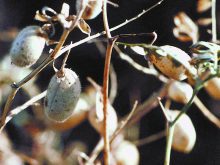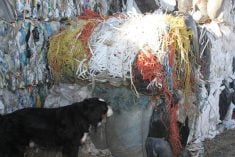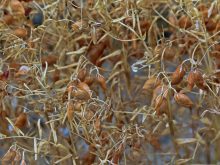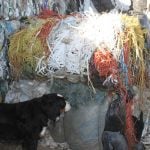Forestry experts from Indian Head, Sask., are encouraging prairie producers to take a look at a new type of shelterbelt that requires less maintenance and less time for establishment.Laura Poppy, agroforestry specialist from Agriculture Canada’s Agroforestry Development Centre, said the ecobuffer uses a diverse variety of tree and shrub species in a high-density, multi-row planting arrangement.The design, which was first adopted in Scandinavian countries, provides all the benefits of a traditional shelterbelt with less maintenance.Poppy said the high planting densities used do not compromise plant or tree growth but minimize competition from weeds.Experts from the agroforestry centre used the design at a variety of demonstration sites across the province, including the Western Beef Development Centre’s Termuende Ranch near Lanigan, Sask.The design is showing great potential on the Prairies.”Maintenance will be extremely minimal,” Poppy told livestock producers attending the WBDC field day June 22 near Lanigan.”Yes, there will still be some maintenance required in the first one to three years, but after that, you’ll be able to walk away and let nature take its course,” she said.”This type of design is still going to give you all the benefits of a (traditional) shelterbelt, so you’re gong to get protection of soil, water, crops, it’s going to enhance biodiversity and … it will protect livestock.”The buffer includes at least four or five shrub species and at least two long-lived tall tree species.Plant heights should be varied and species should offer a variety of characteristics, including tall, short, thorny, fruiting, fast growing and slow growing.Plants should be native species that are well adapted to the planting site and suckering plants are encouraged because they increase the number of plants in the buffer.In an ideal planting arrangement, the number of individual trees and shrubs will increase tenfold within the first five years due to suckering.”It’s a lot different than just putting in a single row of trees of carraganas,” she said. “In this design, there’s lots of biodiversity, lots of different species and lots of suckering.”While more research is planned, agroforestry specialists say an ideal ecobuffer would include three to five rows in a narrow, densely planted arrangement.The buffers should be connected to riparian zones, wildlife corridors or wooded areas.In-row spacing should be approximately one metre and between-row spacing should be two metres.Exterior rows should include a higher proportion of small or short shrubs. For interior rows, every sixth plant should be a long-lived tree.Additional time and expense are associated with planting at higher-than-normal densities.Fencing costs should also be factored into overall establishment costs if the buffers are used in pastures or around livestock.”It definitely needs to be fenced off to keep the cattle out, which is important, because otherwise they’ll get in there and trash the place.”Species that are well suited to ecobuffers in the aspen parklands include:* dogwood* snowberry* pincherry* trembling aspen* potentilla* balsam poplar* buffaloberry* Manitoba maple* woods rose* chokecherry* green ash* white spruce* saskatoonFor more information, contact the Agroforestry Development Centre at 866-766-2284.
Read Also

Message to provincial agriculture ministers: focus on international trade
International trade stakeholders said securing markets in the face of increasing protectionism should be the key priority for Canada’s agriculture ministers.















